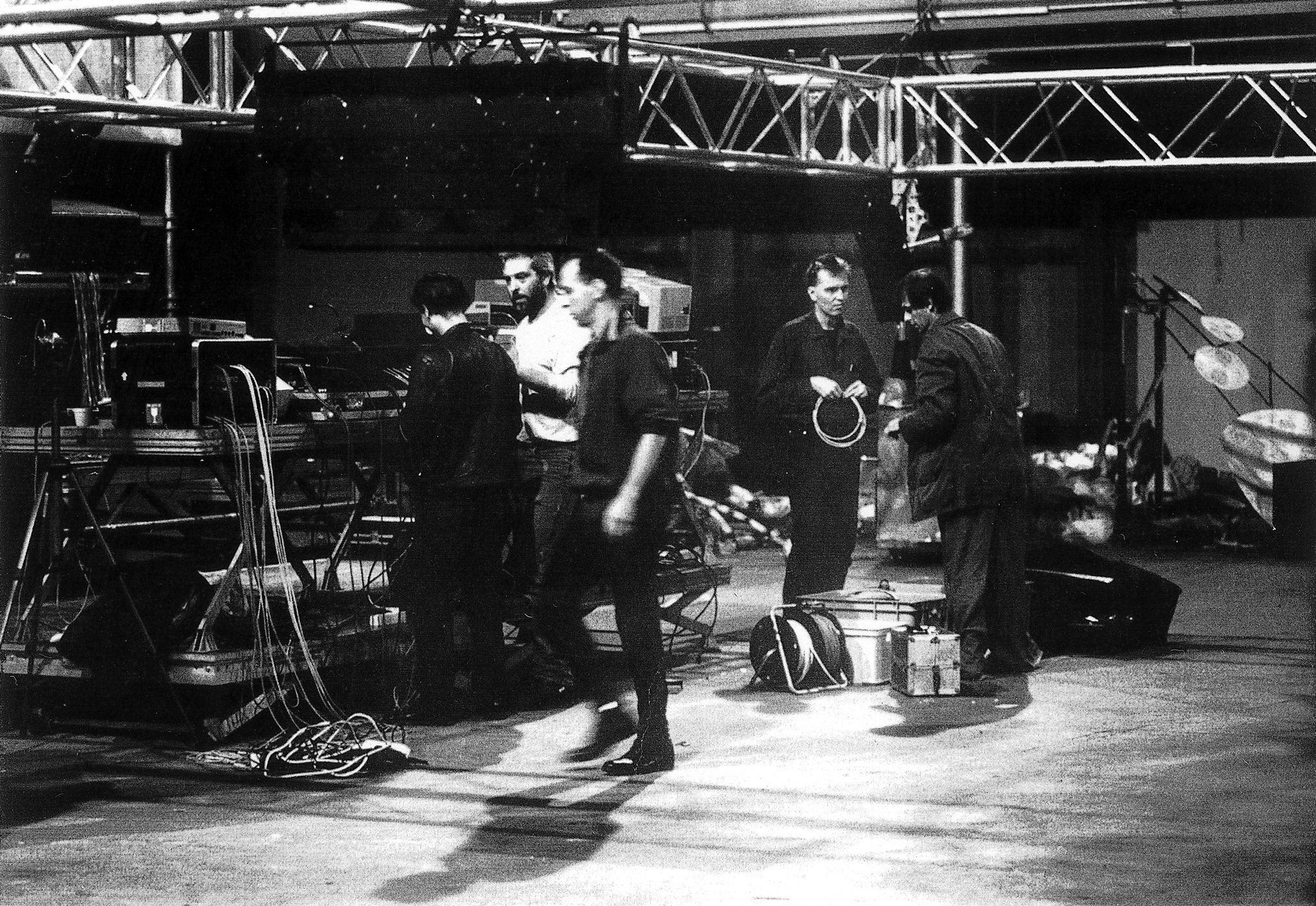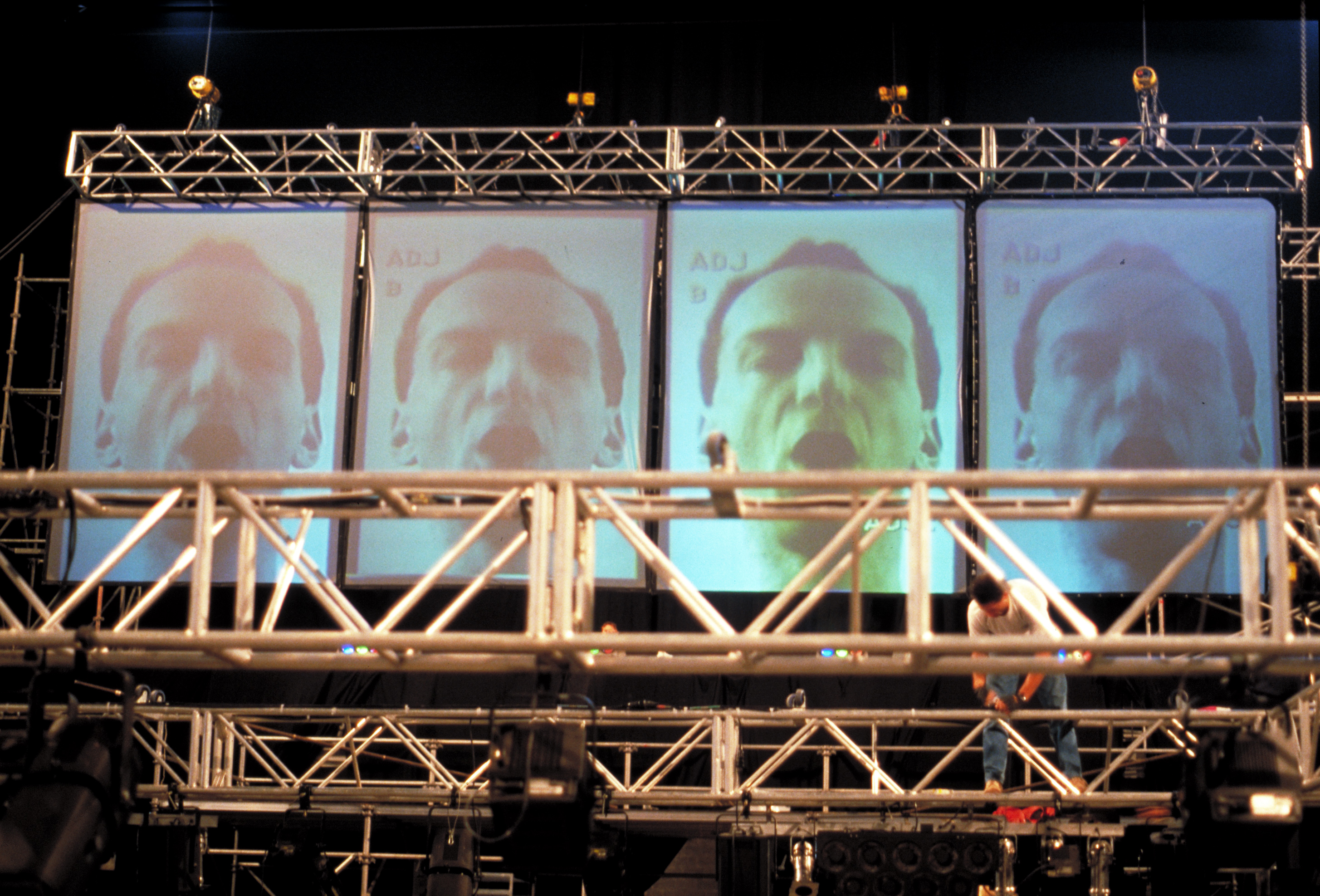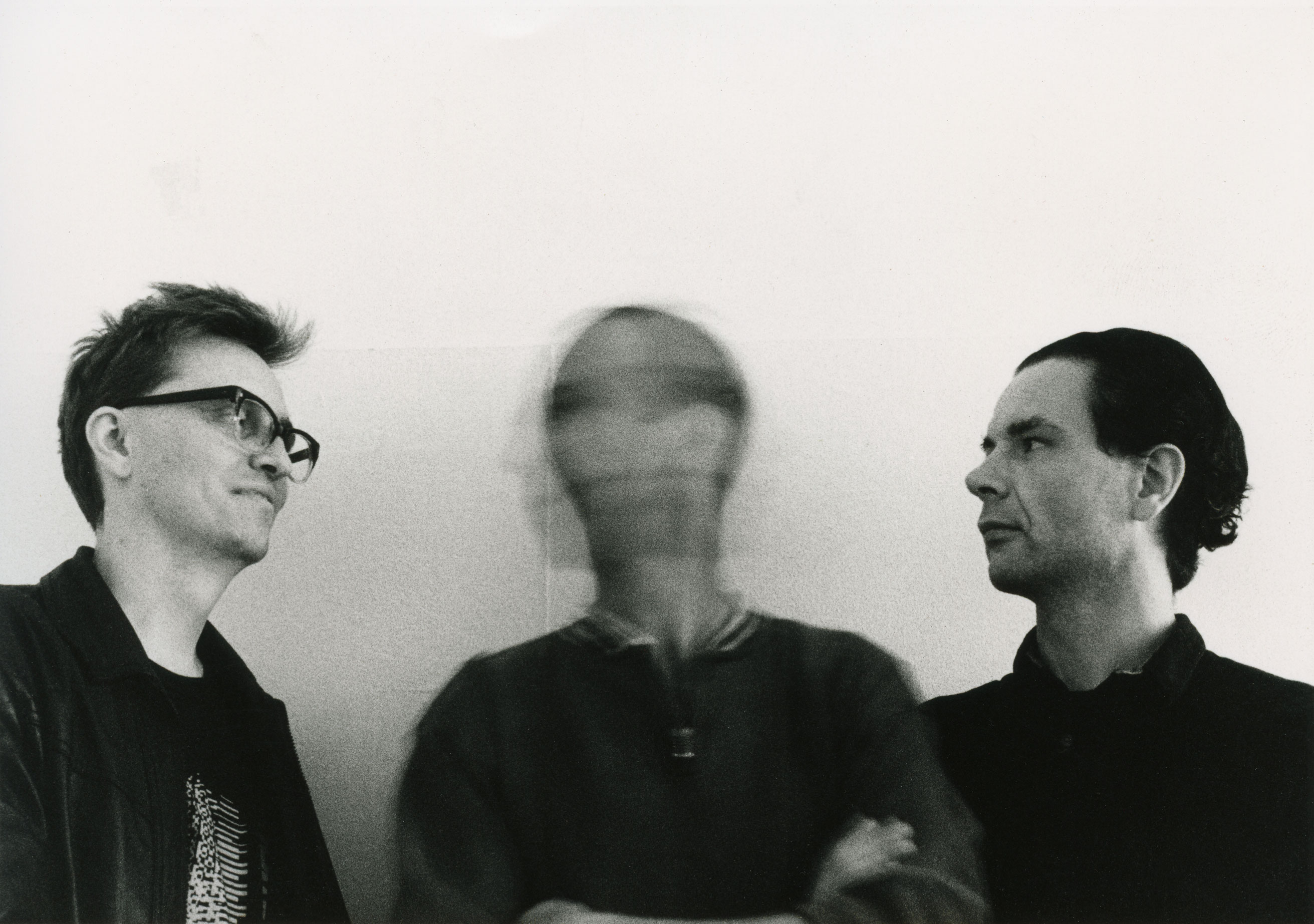MODELL 3
1992-1993
Audiovisual Performance and Installation
4-Channel portrait Video, 6-Channel Audio
Featuring Performer Michael Krammer







MODELL 3
An multimedia live environment by
Kurt Hentschläger and Ulf Langheinrich.
1. The Environment:
Four video projectors project images onto four backdrop screens (measuring 2 x 3 metres upright size) hanging from the ceiling; the images originate from three U-matic players and one camera recording live. The images show the full-screen portrait of a male head against a white background. Each of the images can be switched to any of the projection screens by means of a video crossbar. Model (performer) Michael Krammer is located in the same building at the same time. One proof of the model's actual presence is the fact that his increasing perspiration shows in the video transmission as the performance goes on. The head's live presence is not in opposition to the mounted and denatured images; in fact, the dual picture of the head (on tape and live) quotes a specifically media-related constellation of performance and representation modes. The features of the head, identical from the angle of performance dependencies, are presented at two different levels, which can always be exemplified by cross-switching or switching through via the video crossbar. Sounds from the U-matic tapes' soundtracks are reproduced via the concert-volume p.a. system geared to creating a physical sensation of pressure. In addition, Ulf Langheinrich combines minimised sequences of control data on a computer to complete the energy-laden mass of sound. The image and sound mixing desk is situated opposite the projection screens, with the space in between being used to accommodate the audience.
2. Looping the Loop: Significant sections (grains) are selected from the tape material, which shows the male head singing/talking/yelling and moving as the performer beats his breast (an act invisible to the eye of the camera). These sections are reproduced and positioned at random. Compared to the original sequences, the final product is denatured by re-arranging, looping, repeating and mixing existing synthesised sequences. In terms of length, the individual grains range from single frames to entire sequences of frames. The editing computer chops and mixes the sequences of images and sounds recorded by the camera like a blender to re-structure them freely outside the time continuum of the video tape. With all sense of time and position lost, natural perception is undermined and confronted with an artificial sequence of images that is actually no longer a sequence. Each image seems to be newly generated in potential simultaneity, i.e. timelessness.
Video tapes differ from (celluloid) film in that there is no possibility to edit by literally cutting individual frames out and replacing them in a different spot. Frames can only be replaced by others when new recordings erase the old ones or when they are transcribed from the master copy. This is specific to the medium and the only way to make up for the relative shortcoming (compared with film) is to devote an adequate amount of time and to use an editing computer. Kurt Hentschläger and Ulf Langheinrich use this shortcoming for the better in that they break with the time continuum by using a mounting technique that is not oriented to film, but the circumstances involved in the use of magnetic tape.
3. The Causal Nexus: It was the LumiËres, who, in the early days of film history, placed individual pictures in chains of cause and effect to create action, with each picture containing the cause of the following one. Film builds causal thinking in terms of three-dimensional space and time, the latter being invariably one-dimensional. Gaps in such causal reasoning (for the first time in film history found in MeliËs) mean that individual links in the chain of pictures have been left out.
When one first views the rushes after a day of shooting the chain of pictures seems to confirm the principle of causality prevalent in Western philosophy (from Aristotle to Descartes and Newton). Hume identified causality as a "necessity of the soul", an idea Hollywood remains committed to until today. Mounting, not the editor's invisible cut makes cause precede effect in a feature film, thus giving the moving picture its special qualities.
To compute things (an expression derived from the Latin word "com-putare", consider together) basically means to look at things in a certain context. Hentschlager's and Langheinrich's mounting technique, which transforms, changes or re-structures Krammer's head or its symbolical representation in the picture, corresponds to the nature of computing. New contexts contradicting our every-day causal thinking evolve, they can only be interpreted in terms of mechanical gestures. The lungs turn into an amplifier (voltage-controlled amplifier), the vocal cords and larynx become an oscillator (VCO), palate and pharynx turn into a filter (VCF). The technical correlate of image and sound ceases to exist and reveals its contents along technical lines. Reality, or rather, reality as we perceive it, is put to a radical test via the perception of mounted/dismounted pictures. A gap opens between so-called "natural" reality on the one and artificial, denatured reality on the other hand - if one defines nature as experience, as Kant does when stating something along the following lines: "Materially, nature is, after all, the essence of all objects of experience."*) The experience mediated by the projection of the head is highly technical, it is an experience that provides an insight into the nature of technology.
"Data also denote dice," says Friedrich Kittler, "as the formerly aesthetic or orderly cosmos of the philosophers turned into a big game of dice through the workings of technology, data processing is able to recombine its operational values aleatorically under all the mathematical rules available until there is no more actual need for reality."**) The aleatoric practice is what Hentschlager/Langheinrich apply to the video image because, given the image grains synthesized by technical means, there is no more need to ask for, let alone reconstruct, nature on the basis of a context of cause and effect. The frames are considered the materialization of a category that is of an abstract nature itself.
The thematic structure of the image-text is not translated into reality in the sequences of images, but in the process that "cracks" them up into randomly computable frames or brief sequences of frames. Images can be replaced by other images and extended to form sequences or images in succession without changing the text of the performance.
4. Hermetic Traits: The film is torn, there is no more beginning and ending, and there is no way out either. Hentschlager and Langheinrich counteract the unconsciously hermetic traits in an illusionistic chain of images guaranteeing self-contained action and suspense by denaturation and layering, which in turn make us aware of hermetic traits in the shape of un-timing. Un-timing does not only denote the re-arrangement of events on the time axis, but primarily an act of layering for the purpose of compression. Polyrhythmic textures of melodies evolve. Parallels to techniques of sound syntheses, such as sampling, wave tables and granular syntheses, are intentional. Bits taken from originally continuous optic and acoustic processes are singled out to form live-less isolated events and turned into the basis of a new construction. According to Hentschlager/Langheinrich the tapes work "like individual oscillators of a space-occupying sound/image generator". "It opens a field of interfering individual levels in space. In many cases, transparency, solidity and hermetic traits are qualities that can be experienced simultaneously in this field, which is the actual site of granular synthesis." A kind of hermetic instant evolves.
3.1 is a model that relinquishes objective reality, or rather the objectivity of the camera lens, for the sake of a new epistemology of the video image. The synthesized images do not want to achieve identity, imitation and illusion, but their destruction. The image of the head is no longer a head, it is a machine; this idea lays the foundation for the self-reflective practice of the performance. The machine extracts traits from the world to simulate the world anew...until the machine provides an insight into the world as a natural experience of the machine?
- Thomas Feuerstein
Catalogue text for TRANSIT 92
*Immanuel Kant (1783): Prologomena zu jeder könftigen Metaphysik. Werke, vol. IV, Königlich Preussische Akademie der Wissenschaften, Berlin 1911, p. 295.
**Friedrich A. Kittler: Fiktion und Simulation, in: Ars Electronica (ed.): Philosophien der neuen Technologie, Berlin 1989, p. 69
-----------------------------
Cezanne mit Ohren. Anmerkungen zum Kunstwerk im Zeitalter der technischen Reproduzierbarkeit
Den Autonomieanspruch der Malerei hat Maurice Denis im späten 19. Jahrhundert damit begründet, daß ein Bild, bevor es etwas darstelle, zunächst eine ebene Flache sei, die mit Farben in einer bestimmten Ordnung bedeckt sei. In diesem emanzipativen Schritt manifestiert sich die Berufung auf die immanenten Bedingungen des Mediums als primäres Legitimationsmoment der künstlerischen Arbeit. Bevor ein Bild etwas repräsentiert, etwas darstellt oder als Zeichen für etwas fungiert, meint es eine Konstruktion von Bedeutung, die Generierung einer symbolisch-sprachlichen Ordnung, die sich der Wahrnehmbarkeit und Lesbarkeit anbietet .
Wenn Hentschläger und Langheinrich nun ihr audivisuelles Material in einzelne Frames oder Grains zu frei verfugbaren Grundbausteinen fur eine neu zu generierende audivisuelle Syntax zerlegen, stehen sie in einer Tradition, die ihre Vorläufer in Cezanne, den Pointilisten und Kubisten oder - mit einem Blick auf die Wortsprache - in Marinetti finden kann. Hier liegt der kunstlerische Ansatz iher Arbeit begrundet - trotz der historischen Distanz und trotz der mediaien Differenz.
Angesichts ihrer Produktion, der eine Analyse ihrer Mittel und Medien als Bedingung vorausgeht, bewegen sich Hentschlager und Langheinrich auf dem Feld der Moderne - mit dem Ziel eine moglichst komplexe Reprasentanz von Wirklichkeit, vermittelt in einer kunstlerischen symbolischen Ordnung, zu entwickeln. Dieser Ansatz spiegelt sich auf verschiedenen Ebenen wider: Schon der Titel ,,Modell" postuliert die Reprasentanz fur etwas. Die Struktur ihrer ,,Modelle" ist gekennzeichnet durch die Verdichtung samtlicher Komponenten zu einer komplexen Grammatik, in der die audivisuellen Partikel einer ubergeordneten Komposition eingeschrieben werden. Diese Kompositionen folgen einer zeitlich-performativen Struktur, in deren Verlauf die artifiziellen Bewegungs- und Klangmomente den realzeitlich authentischen Elementen eines life anwesenden Modells bis zur ununterscheidbaren Fusionierung einander angenahert oder evident voneinander entfernt werden. Die visuelle Struktur operiert mit Symmetrien und Intervallen und wird durch eine akustische Struktur kommentiert. Die Spannung zwischen den einzelnen Ebenen ergibt sich aus ihrer wechselseitigen Beeinflussung und Verschiebung.
Auf diese Weise wird eine asthetische Struktur erzeugt, in der die artifiziellen und real eingespielten Sequenzen aufeinander bezogen werden, indem ein Switchen zwischen den Ebenen des Realen und Konstruierten moglich und notwendig wird. Vielleicht liegt darin die ,,Modellhaftigkeit" ihrer Arbeiten, in denen die Differenz zwischen den Milieus nicht als Verlust, sondern als Chance betrachtet wird.
-Andreas Spiegl, Institute Of Contemorary Art, Academy of Fine Arts, Vienna

